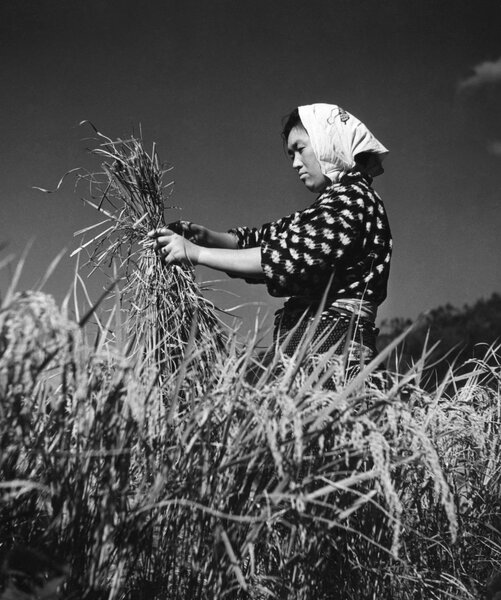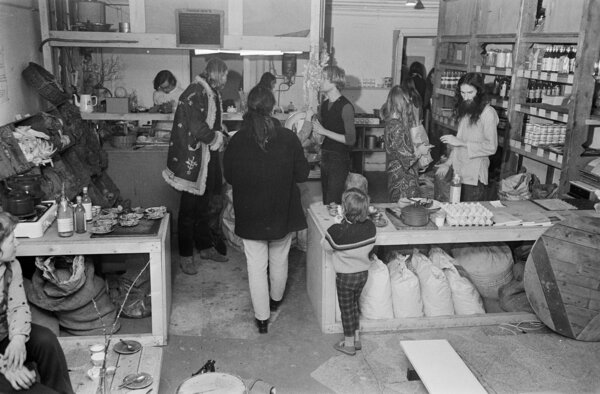Community-supported agriculture programs boomed during the pandemic, but the seeds were cultivated decades beforehand.
Welcome to Origin Story, a series that chronicles the lesser-known histories of designs that have shaped how we live.
Community Supported Agriculture (CSA) programs boomed during the Covid pandemic as city dwellers and suburbanites across the country found themselves avoiding grocery stores and restaurants and spending a lot more time cooking at home, as well as looking for ways to support struggling small businesses, including local farms. For an average annual fee of $400 to $700 per year, consumers buy "shares" from local farms in exchange for boxes of fresh produce throughout a given season. Those boxes run the gamut, offering everything from vegetables, meat, dairy, and flowers to wine and even gelato. But the concept is hardly new: Let’s turn our attention to the radical history of CSAs.

Japan's teikei movement, often referred to as the Japanese version of community-supported agriculture, emerged in the 1960s, with the first consumer-led initiatives organized by women.
Photo by Touring Club Italiano/Marka/Universal Images Group via Getty Images
International Sowing
There’s no consensus on the origins of the CSA concept, but similar community farm initiatives gained momentum in Japan, Chile, and across Europe after World War II. In the mid-1960s, a group of Japanese women, concerned about the safety and quality of increasingly industrialized, chemically intensive agriculture, approached a local farm family with an idea to create a farmer-consumer partnership involving direct supplies of organic foods, and the teikei movement (referred to as Japan’s CSA movement) was born. In the late ’70s, proto-CSA models began to take hold in Europe, inspired largely by the Austrian occultist Rudolf Steiner and his 1920s teachings on biodynamic agriculture and "associative economics," as well as Chilean agricultural unions and cooperatives that sprung up in the late ’60s and early ’70s.

Horticulturist and agricultural professor Booker T. Whatley (pictured above right) advocated pioneering solutions for Black farmers in the postwar era and popularized the concept of "pick-your-own" farm operations, as well as "clientele membership clubs" for small farmers.
Courtesy Tuskegee University Archives, Tuskegee University
Civil Rights and Farm Commandments
At the height of the civil rights movement, Booker T. Whatley, a Black horticulturist and agriculture professor at Alabama’s Tuskegee Institute, pioneered solutions for struggling Black farmers, who were often denied loans from the federal government. Whatley eventually published these ideas, gleaned from decades of research, in the 1987 handbook How to Make $100,000 Farming 25 Acres, which is still embraced by small-scale farmers. In it, he put forth a list of "10 Farm Commandments," the second of which is what he called a "pick-your-own operation." The idea, according to Whatley, is to charge local community members a fee, in exchange for which they can come to the farm and pick their own produce. He also advocated "clientele membership clubs," where customers paid upfront for a season of food as a way of ensuring the farm’s prosperity.

The CSA model popularized in the U.S. is most commonly associated with Massachusetts’ Indian Line Farm and Temple-Wilton Community Farm in New Hampshire, both founded in the mid-’80s and heavily influenced by biodynamic agricultural traditions that were cultivated in postwar Europe. Above, people shop for biodynamic foods at a 1971 spring fair in Amsterdam.
Photo by Sepia Times/Universal Images Group via Getty Images
See the full story on Dwell.com: How CSAs Took Root in the U.S.
Related stories:
- We’ll Never Climb Down From the Tree House
- Hate That Vacant Lot in Your Neighborhood? Turn It Into Something Great
- Editor’s Letter: Fresh Ideas for Outdoor Living
Read More
By: Angela Serratore
Title: How CSAs Took Root in the U.S.
Sourced From: www.dwell.com/article/history-of-community-supported-agriculture-csa-box-subscriptions-6a74855d
Published Date: Tue, 07 May 2024 12:02:19 GMT
.png)





